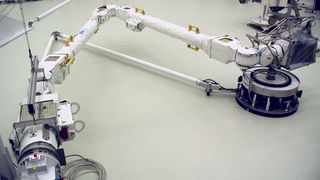Europe will launch a new two-handed robotic arm to the International Space Station soon
A new robot will help astronauts take care of the International Space Station.

An autonomous robotic arm is readying to fly to the International Space Station to service its Russian segment.
The European Robotic Arm (ERA), built by European aerospace company Airbus for the European Space Agency (ESA), will fly to the orbital outpost on July 15 together with the new Russian Multipurpose Laboratory Module, also known as Nauka (the Russian word for science). Airbus engineers have already installed the lightweight arm onto the module, ahead of its launch from the Russian Space Agency Roscomos' Baikonur Cosmodrome in Kazakhstan on a Proton rocket, Airbus said in a statement.
The robot resembles a pair of compasses with two symmetrical arms, each a little over 16 feet (5 meters) long. Fitted with a dexterous hand at the end of each arm, ERA will be able to move freely outside of the space station, attaching itself wherever it's needed, ESA said in a statement.
Related: Space station robotic arm hit by orbital debris in 'lucky strike' (video)
Weighing only 1,390 lbs. (630 kilograms), thanks to its lightweight aluminum and carbon-fiber structure, the arm will be able to move and install components up to 17,600 lbs. (8,000 kg) in weight while being able to reach targets with 5 millimeter precision. But it could also transport astronauts and cosmonauts during spacewalks from one working site to another.
Astronauts and cosmonauts will be able to either control the arm in real time from inside the space station or pre-program it to carry out tasks autonomously.
The arm also has an additional computer in the middle, which could be used by astronauts and cosmonauts to enter instructions during spacewalks.
Get the Space.com Newsletter
Breaking space news, the latest updates on rocket launches, skywatching events and more!
Fitted with an infrared camera, ERA can inspect the space station’s structure and components and stream its view to the astronauts and cosmonauts inside the orbiting lab.
With two decades of development, the arm was built by a consortium of European companies led by Airbus, which then assembled the robot at its facilities in the Netherlands.
The International Space Station already has two robotic arms: the 17m-long Canadarm2 and the 10m-long Japanese Experiment Module Remote Manipulator System. However, neither of these can reach the Russian segment of the space station.
Follow Tereza Pultarova on Twitter @TerezaPultarova. Follow us on Twitter @Spacedotcom and on Facebook.
Join our Space Forums to keep talking space on the latest missions, night sky and more! And if you have a news tip, correction or comment, let us know at: community@space.com.

Tereza is a London-based science and technology journalist, aspiring fiction writer and amateur gymnast. Originally from Prague, the Czech Republic, she spent the first seven years of her career working as a reporter, script-writer and presenter for various TV programmes of the Czech Public Service Television. She later took a career break to pursue further education and added a Master's in Science from the International Space University, France, to her Bachelor's in Journalism and Master's in Cultural Anthropology from Prague's Charles University. She worked as a reporter at the Engineering and Technology magazine, freelanced for a range of publications including Live Science, Space.com, Professional Engineering, Via Satellite and Space News and served as a maternity cover science editor at the European Space Agency.
